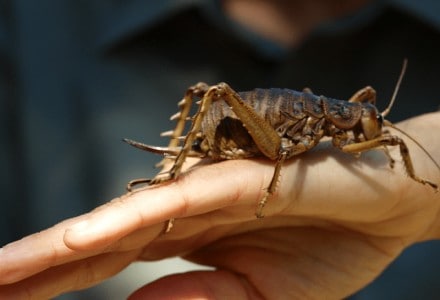
Giant Weta Facts
- The Giant Weta serves as the collective name for any one of 11 specific species in the genus Deinacrida, which itself also forms a sub-group of the 70 known species of Weta. Genetically, all remain rather close relatives of the common cricket.
- All Weta that we know of, including the giant one, evolved as endemic only to a single island in New Zealand. These all represent excellent examples of Island Gigantism.
- The IUCN also lists all varieties in this genus as Vulnerable or worse. This occurs due to its extremely limited habitat range, which makes it highly vulnerable to both habitat loss and climate change.
Giant Weta Physical Description
The different forms of Giant Weta by no means form the largest of insects, with the largest species (which inhabits only Little Barrier Island) reaching about 4 in (10 cm) in length.
Yet they do, however, rank among the heaviest of all insects that scientists know of. The heaviest specimen on record weighed 2.5 ounces (72 grams), or about three times the weight of the average household mouse.
They also possess no wings, despite their resemblance to katydids from North America, and remain capable of producing painful bites.
Coloring also varies dramatically between the different varieties, yet various shades of brown predominate.
Kingdom: Animalia
Phylum: Euarthropoda
Class: Insecta
Order: Orthoptera
Family: Anostostomatidae
Genus: Deinacrida
Photographer: Chris Winks
CC License: https://bit.ly/1PKFaP7
Giant Weta Distribution, Habitat, and Ecology
Though inhabiting only the single island of New Zealand, the creatures live in a wide range of habitats on it. These include shrub, forests, pasture, and caves.
The remarkable Giant Weta remains principally herbivorous, but will occasionally prey upon smaller insects as well.
The Giant Weta appears to be primarily nocturnal in nature.
Check out our articles on Giant Lubber Grasshopper, Desert Locust, Magicicada

